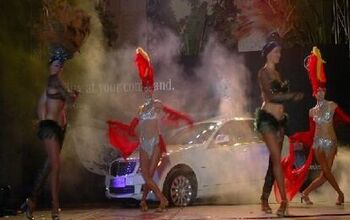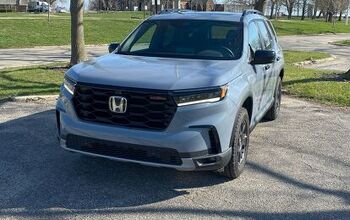The Truth About EVs: They Will Be Nuclear Powered

“I want to make nuclear power generation ‘visible’ through electric vehicles,” says Takafumi Anegawa, a former nuclear engineer who works for Tokyo Electric Power Co. He thinks that “electric cars are the best tool to help people understand the importance of nuclear power,” reports The Nikkei [sub].
Anegawa heads up the CHAdeMo Association. With 236 member firms and organizations, the group aims to promote the installation of electric vehicle chargers. The group’s suggestions stand a good chance to make a method of electrical charging developed in Japan the global standard via the ECE.
Anegawa was one of the first promoters of electrical cars – to promote nuclear energy.
“Every time there is a problem at a nuclear power plant, people see nuclear power generation as something bad,” Anegawa said. He thought electric vehicles could change people’s perceptions.
People with green leanings may not want to hear it, but pretty much the only sensible way to produce the power needed to charge masses of electric vehicles would be nuclear. Burning fossil fuels simply moves the exhaust from the car to power plant chimneys. Hydro-electric, solar, or wind powered? Dream on.
In many countries of the world, there had been a moratorium on nuclear power. No new nuclear power plants had been built in the U.S.A. since the 1970s. In February 2010, the two new nuclear power plants had been approved, the first in 30 years. In Germany, building of new nuclear plants had been against the law for years, and Germany wanted to be nuclear-free by 2021. Now, nuclear power looks more and more like it’s here to stay.
Broad acceptance of electric cars, combined with what is happening off the coast of Louisiana, could very well become the impetus for a resurgence of nuclear power.

Bertel Schmitt comes back to journalism after taking a 35 year break in advertising and marketing. He ran and owned advertising agencies in Duesseldorf, Germany, and New York City. Volkswagen A.G. was Bertel's most important corporate account. Schmitt's advertising and marketing career touched many corners of the industry with a special focus on automotive products and services. Since 2004, he lives in Japan and China with his wife <a href="http://www.tomokoandbertel.com"> Tomoko </a>. Bertel Schmitt is a founding board member of the <a href="http://www.offshoresuperseries.com"> Offshore Super Series </a>, an American offshore powerboat racing organization. He is co-owner of the racing team Typhoon.
More by Bertel Schmitt
Latest Car Reviews
Read moreLatest Product Reviews
Read moreRecent Comments
- ToolGuy First picture: I realize that opinions vary on the height of modern trucks, but that entry door on the building is 80 inches tall and hits just below the headlights. Does anyone really believe this is reasonable?Second picture: I do not believe that is a good parking spot to be able to access the bed storage. More specifically, how do you plan to unload topsoil with the truck parked like that? Maybe you kids are taller than me.
- ToolGuy The other day I attempted to check the engine oil in one of my old embarrassing vehicles and I guess the red shop towel I used wasn't genuine Snap-on (lots of counterfeits floating around) plus my driveway isn't completely level and long story short, the engine seized 3 minutes later.No more used cars for me, and nothing but dealer service from here on in (the journalists were right).
- Doughboy Wow, Merc knocks it out of the park with their naming convention… again. /s
- Doughboy I’ve seen car bras before, but never car beards. ZZ Top would be proud.
- Bkojote Allright, actual person who knows trucks here, the article gets it a bit wrong.First off, the Maverick is not at all comparable to a Tacoma just because they're both Hybrids. Or lemme be blunt, the butch-est non-hybrid Maverick Tremor is suitable for 2/10 difficulty trails, a Trailhunter is for about 5/10 or maybe 6/10, just about the upper end of any stock vehicle you're buying from the factory. Aside from a Sasquatch Bronco or Rubicon Jeep Wrangler you're looking at something you're towing back if you want more capability (or perhaps something you /wish/ you were towing back.)Now, where the real world difference should play out is on the trail, where a lot of low speed crawling usually saps efficiency, especially when loaded to the gills. Real world MPG from a 4Runner is about 12-13mpg, So if this loaded-with-overlander-catalog Trailhunter is still pulling in the 20's - or even 18-19, that's a massive improvement.


































Comments
Join the conversation
Modular nukes (
I've always liked Dr. Jerry Pournelle's solution to the nuclear waste issue (first published 30 years ago in 'A Step Further Out'!) but he's still in general agreement with it today. "First, nuclear waste is a non-problem. The simplest method of dealing with them is to encase the stuff in glass (actually make a glass with the waste as ingredients) then take it to the Mindanao Trench and drop it overboard. It will eventually be carried into the depths of the earth where it came from in the first place. End of problem. What most people do not seem to know is that while "nuclear waste" is in fact radioactive for thousands of years, after about 600 years the only radioactivity remaining is from the actinides, and those are what caused it to be fuel in the first place; after about 600 years the residuals are less active than the original ores mined in the first place. And if we don't like dumping the stuff in the Deep (where we can't retrieve it if we suddenly wish we had it) then again make glass of it, and stack it in the Mojave desert. A square mile of the Fort Irwin maneuver area would do for many years to come. If you really doubt the stability of glass (which is pretty near eternal) build a superdome over it. Put a triple chain link fence topped with razor wire around the site with a notice that anyone crossing the line is fair game for the Army, but you'll probably die before we can kill you. Have a nice day." Although in the original article his sign was more straightforward -> "If you cross this fence you will DIE"